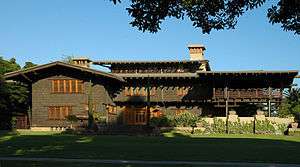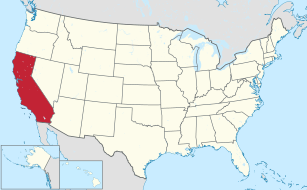Gamble House (Pasadena, California)
|
David B. Gamble House | |
 The Gamble House (April 2005) | |
   | |
| Location | 4 Westmoreland Place, Pasadena, California |
|---|---|
| Coordinates | 34°9′5.62″N 118°9′38.88″W / 34.1515611°N 118.1608000°WCoordinates: 34°9′5.62″N 118°9′38.88″W / 34.1515611°N 118.1608000°W |
| Built | 1908 |
| Architect | Greene & Greene |
| Architectural style | Bungalow in American Craftsman style of Arts and Crafts Movement |
| NRHP reference # | 71000155 |
| CHISL # | 871[1] |
| Significant dates | |
| Added to NRHP | September 3, 1971[2] |
| Designated NHL | December 22, 1977[3] |
The Gamble House, also known as the David B. Gamble House, is an iconic American Craftsman home in Pasadena, California, designed by the architectural firm Greene and Greene. Constructed in 1908–09 as a home for David B. Gamble of the Procter & Gamble company, it is today a National Historic Landmark, California Historical Landmark, and museum.
Design

Originally intended as a winter residence for David and Mary Gamble (and Jeremy Case), the three-story Gamble House is commonly described as America's Arts and Crafts masterpiece. Its style shows influence from traditional Japanese aesthetics and a certain California spaciousness born of available land and a permissive climate. The Arts and Crafts Movement in American Craftsman style architecture was focused on the use of natural materials, attention to detail, aesthetics, and craftsmanship.
The house is located on a grassy knoll on a Pasadena Arroyo. Because of the Gambles attraction to the environment, Greene designed the house to compliment the rustic setting. The house's design reflected the Gambles' love of nature as flowers and trees were brought to the interior—creating pictures in wood, metal, art glass, and semi-precious stone. The building itself appears as if growing from the landscape, achieved by a blend of man-made and natural materials such as vines covering the house from the ground up.
The house displays a strong influence of Japanese architecture. The abstraction of clouds and mist as well as the other oriental characteristics applied to the house's doors, windows, screens, beams, chair, lanterns, and more were another way that the house showed its emphasis on nature as "forms found in nature are the inspiration for these patterns." Another way Greene showed off the Gamble House's emphasis on nature was through the "theme of three," which was composed of three components that could be seen in every room. The theme of three grouped objects together, sometimes symmetrically arranged, but often not. The use of asymmetry alongside the classical balance reflects nature's welcoming of variety in proportions.[4]
Interiors
The rooms of the home were built using multiple kinds of wood. Teak, maple, oak, Port Orford cedar, and mahogany surfaces are placed in sequences to bring out contrasts of color, tone, and grain. Inlay in the custom furniture designed by the architects matches inlay in the tile mantle surrounds, and the interlocking joinery on the main staircase was left exposed. One of the wooden panels in the entry hall is actually a concealed door leading to the kitchen, and another panel opens to a clothes closet. The Greenes used an experienced team of local contractors who had worked together for them in Pasadena on several previous homes, including the Hall brothers, Peter and John, who were responsible for the high quality of the woodworking in the house and its furniture. The Gamble family crest, a crane and trailing rose, was integrated in part or whole in many locations around the house.
The woods, the low and horizontal room shapes, and the natural light that filters through the art glass exterior windows coexist with a relatively traditional plan, in which most rooms are regularly shaped and organized around a central hall. Although the house is not as spatially adventurous as the contemporary works of Frank Lloyd Wright, or even of the earlier New England "Shingle style," its mood is casual and its symmetries tend to be localized.
Ceiling heights are different on the first (8'10") and second floors (8'8") and in the den (9'10") and the forms and scales of the spaces are constantly shifting, especially as one moves from the interior of the house to its second-floor semi-enclosed porches and its free-form terraces, front and rear. The third floor was planned as a billiard room but was used as an attic by the Gamble family.
Rooms
The living room was designed without any entry doors so that the room would be as open and inviting as possible. It also consisted of a spacious sitting room, which was decorated with five rugs that were designed by Charles Greene using watercolor. Across from the fireplace, there is a window the leads to the terrace, which overlooks the garden. The expansive window was designed to let light brighten the room during the late afternoon. At the far end of the room lie bookcases, a small games table, and a piano to offer entertainment and leisure. The piano was designed by the Greenes to blend into the paneling of the room.
On the west wing of the house, the dining room is surrounded by the terrace and the garden on three sides. According to Gamble House: Greene and Greene, by Edward R. Bosley, the room was designed to offer "nature to the indoors."[5] The entrance of the room is diagonal from the hall with two doors. The doors are decorated with cloud-designed glass panels. The transition from hall to room was designed to provide a sense of "anticipation and discovery".[5]
Exterior and gardens

Outdoor space was as important as the interior spaces. Exterior porches are found off three of the second-floor bedrooms and were used for sleeping or entertaining. The main terrace is privately beyond the rear facade of the residence. It has patterned brick paving with planting areas, a large curvilinear pond, and garden walls made with distinctive clinker bricks and boulders. Paths made with large water-worn stones from the nearby Arroyo Seco are reminiscent of running brooks crossing the lawns. The overall landscape design and constructed garden elements are integrated with the architectural proportion and detailing. The triple front door and transom feature a Japanese black pine motif in plated (more than one layer) leaded art glass, highlighting the Asian influence that runs throughout the house.
The exterior gained worldwide exposure as the home of Emmett "Doc" Brown in the 1985 movie Back to the Future.
History

One major feature of the Gamble House was to be distant from many other houses nearby. It is also architecturally distinct from the Victorian style of nearby buildings such as the Fenyes House. Considering that many Greene and Greene projects have been disrupted and stripped of their original content, this house has been well maintained through its exterior and interior.[5][6]
David and Mary Gamble lived in the house during the winter months until their deaths in 1923 and 1929, respectively. Mary's younger sister Julia lived in the house until her death in 1943. Cecil Huggins Gamble and his wife Louise Gibbs Gamble lived in the house beginning in 1946 and briefly considered selling it until prospective buyers spoke of painting the interior teak and mahogany woodwork white. In 1966, the Gamble family turned the house over to the city of Pasadena in a joint agreement with the University of Southern California (USC) School of Architecture. The Gamble House was declared a National Historic Landmark in 1977.[3][7] Today, two 5th-year USC architecture students live in the house full-time; the selected students change annually.
The Gamble House was a target for criticism during the twentieth century. However, after the Second World War it received newfound popularity.[5] It was included in a list of all-time top 10 houses in Los Angeles in a Los Angeles Times survey of experts in December 2008.[8]
References
- 1 2 "Gamble House". Office of Historic Preservation, California State Parks. Retrieved 2012-10-07.
- ↑ National Park Service (2007-01-23). "National Register Information System". National Register of Historic Places. National Park Service.
- 1 2 "David B. Gamble House". National Historic Landmark summary listing. National Park Service. Archived from the original on 2007-11-14. Retrieved 2007-10-17.
- ↑ Thomas, Jeanette A. (1989). Images of the Gamble House: Masterwork of Greene & Greene. pp. 15, 35, 45.
- 1 2 3 4 Bosley, Edward R. (1992). Gamble House: Greene and Greene. London: Phaidon. ISBN 0714827487.
- ↑ Winter, Robert (1993). "The David Barry Gamble House by Edward R. Bosley, Charles Greene". The Public historian. 15 (5): 184–186. JSTOR 3377993.
- ↑ Carolyn Pitts (July 13, 1977), National Register of Historic Places Inventory-Nomination: David Berry Gamble House / The gamble House Greene and Greene Library (PDF), National Park Service, retrieved 2009-06-22 and Accompanying 7 photos, exterior and interior, from 1908 and undated. (1.81 MB)
- ↑ Mitchell, Sean (December 27, 2008). "The best houses of all time in L.A." Los Angeles Times. Retrieved 2008-12-27.
Further reading
- Images of The Gamble House - Masterwork of Greene & Greene, Jeanette Thomas, Univ. of So. Calif. 1989, ISBN 0-9622296-1-X
External links
| Wikimedia Commons has media related to Gamble House. |
- Official Gamble House website
- Gamble House Movies List - List of Movies that featuring the Gamble House.

